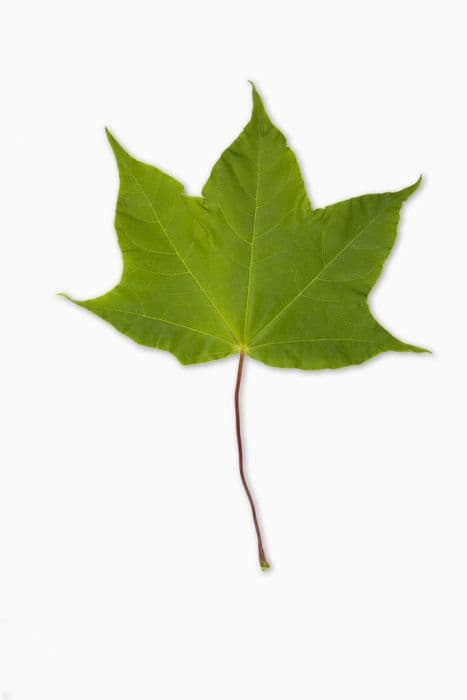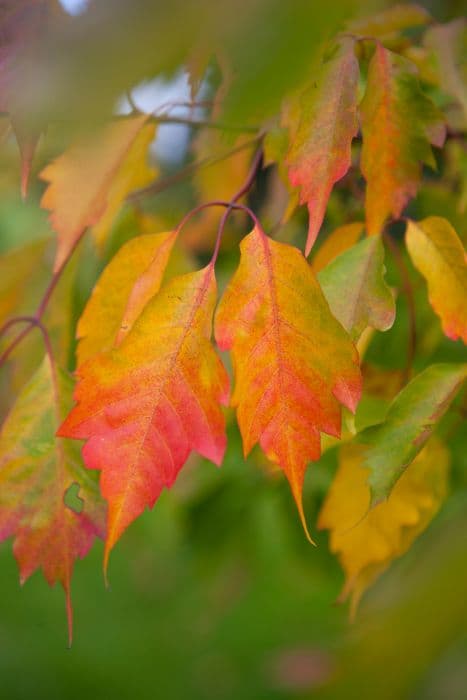Japanese maple 'Butterfly' Acer palmatum 'Butterfly' (P/v)

ABOUT
'Butterfly' is a rather upright shrub or small tree with 5- to 7-lobed leaves irregularly margined with creamy-white and often tinged pink. Occasionally has small red flowers in spring
About this plant
 Names
NamesFamily
Sapindaceae
Synonyms
Butterfly Japanese Maple
Common names
Acer palmatum 'Butterfly'.
 Characteristics
CharacteristicsLife cycle
Perennials
Foliage type
Deciduous
Color of leaves
Variegated
Height
6-8 feet (1.8-2.4 meters)
Spread
4-6 feet (1.2-1.8 meters)
Plant type
Tree
Hardiness zones
5-8
Native area
Japan
Benefits
 General Benefits
General Benefits- Aesthetic Appeal: Japanese Maple 'Butterfly' offers visual interest with its variegated leaves, which have a blend of green, white, and often pink tones, enhancing garden beauty year-round.
- Seasonal Color: The foliage undergoes a stunning transformation in fall, when the leaves turn vibrant shades of crimson, orange, or yellow.
- Compact Growth: With its small size and slow growth rate, it fits well in limited spaces and works well for containers or small gardens.
- Shade Tolerance: It tolerates partial shade, making it a versatile choice for landscaping in a variety of light conditions.
- Low Maintenance: Once established, Japanese Maple 'Butterfly' requires minimal pruning and care, making it suitable for busy gardeners.
- Cold Hardiness: It is relatively hardy in cold climates, able to survive in USDA zones 5 through 8.
- Wildlife Attraction: The tree can attract birds and butterflies to the garden, adding interest and supporting biodiversity.
 Medical Properties
Medical PropertiesThis plant is not used for medical purposes.
 Air-purifying Qualities
Air-purifying QualitiesThis plant is not specifically known for air purifying qualities.
 Other Uses
Other Uses- Photography: The distinct variegated foliage of Japanese Maple 'Butterfly' can provide an inspiring subject for macro and nature photography, capturing the intricacies of leaf patterns.
- Artistic inspiration: Artists may use the contrasting colors and delicate structure of the leaves as inspiration for paintings, drawings, or textile patterns.
- Bonsai: Japanese Maple 'Butyfly' can be trained into a bonsai, offering a way to practice this ancient horticultural art form and create a miniature landscape.
- Seasonal celebrations: Branches of 'Butterfly' can be used in decorations for seasonal events like autumn festivals, providing natural and aesthetically pleasing elements to the décor.
- Crafts: Pressed leaves of the 'Butterfly' can be used in crafting activities, such as making bookmarks, greeting cards, or in decoupage projects.
- Garden photography backdrops: With its striking foliage, the 'Butterfly' can serve as a beautiful backdrop for garden photography, enhancing the appeal of other garden features in pictures.
- Tattoo designs: The unusual leaf shapes and color patterns can inspire tattoo artists to create unique and personalized botanical tattoo designs.
- Educational tool: The 'Butterfly' can be used in educational settings to teach about plant biology, horticulture, and the variation that occurs in leaf patterns and shapes.
- Landscape design: The tree can be strategically placed to create focal points or to frame views in landscape architecture, leveraging its aesthetic qualities.
- Urban green space: In city environments, Japanese Maple 'Butterfly' can contribute to green space by providing a small, decorative tree that fits into tighter urban plantings and courtyards.
Interesting Facts
 Feng Shui
Feng ShuiThe Japanese Maple is not used in Feng Shui practice.
 Zodiac Sign Compitability
Zodiac Sign CompitabilityThe Japanese Maple is not used in astrology practice.
 Plant Symbolism
Plant Symbolism- Beauty and Elegance: The variegated foliage and delicate structure of the Japanese Maple symbolize beauty and grace in the plant world.
- Change and Transformation: The changing colors of the leaves through the seasons from spring through fall represent the idea of change and the natural cycle of life and transformation.
- Peace and Tranquility: Often found in serene gardens, the Japanese Maple is considered a symbol of peace and quite repose.
- Balance and Harmony: The balanced shape and growth habit of the Japanese Maple lend to its symbolism of harmony and equilibrium, fitting in both natural and cultivated landscapes.
- Endurance and Longevity: As a plant that can live for many decades, the Japanese Maple also stands for endurance and the ability to withstand the test of time.
 Water
WaterJapanese Maple 'Butterfly' should be watered deeply to ensure the soil is moist but not soggy, encouraging strong root development. Water approximately once a week, adding about 1.5 gallons of water for each tree, depending on weather conditions such as heat and wind. During hot, dry spells, watering may need to increase to twice a week. Conversely, reduce the watering frequency during rainy periods or cool weather. Always check the moisture level of the soil before watering to avoid overwatering.
 Light
LightJapanese Maple 'Butterfly' thrives best in partial shade to full sun. An ideal spot would receive morning sunlight and afternoon shade, protecting the delicate leaves from harsh midday sun that can cause leaf scorch. Dappled sunlight under taller trees also provides a suitable environment for the 'Butterfly' variety.
 Temperature
TemperatureJapanese Maple 'Butterfly' prefers temperate climates and can handle temperatures down to about -10°F, although keeping them in areas where winters temperatures don't frequently drop below 20°F is ideal. The optimum temperature range for a Japanese Maple 'Butterfly' is between 60°F and 80°F. They can withstand short periods of higher or lower temperatures, but prolonged exposure to extremes can be harmful.
 Pruning
PruningPrune the Japanese Maple 'Butterfly' mainly to remove dead or damaged branches, to shape the tree for aesthetic purposes, and to encourage healthy growth. The best time to prune is during the late winter or early spring before new growth starts. Light pruning can also be done during the summer if necessary but avoid heavy pruning during this time.
 Cleaning
CleaningAs needed
 Soil
SoilJapanese Maple 'Butifly' thrives in well-draining soil with a pH range of 5.5 to 6.5. A mix containing peat, pine bark, and perlite can ensure proper drainage and aeration.
 Repotting
RepottingJapanese Maples like 'Butifly' need repotting every 2-3 years to prevent root crowding and replenish nutrients.
 Humidity & Misting
Humidity & MistingJapanese Maple 'Butifly' prefers moderate to high humidity levels but is adaptable to average outdoor conditions.
 Suitable locations
Suitable locationsIndoor
Place Japanese Maple 'Butifly' in bright, indirect light indoors.
Outdoor
Plant in partial shade with shelter from strong winds.
Hardiness zone
5-8 USDA
 Life cycle
Life cycleAcer palmatum 'Butterfly', commonly referred to as the Japanese Maple 'Butterfly', begins its life cycle as a seed, which after stratification, germinates in early spring. The seedling grows gradually, developing a fibrous root system and characteristic lobed leaves that showcase their variegated, creamy-white and green color with hints of pink. As a juvenile, the plant increases in height and branch density over several years. Upon reaching maturity, the Japanese Maple 'Butterfly' produces small purple flowers in spring which give way to winged samaras, the helicopter-like seeds that disperse in the wind. In autumn, the leaves of the mature tree turn vibrant shades of gold, crimson, and purple before they fall. The plant continues to live and grow for numerous years, capable of reaching ages of 60 years or more, with minimal decline in vigor if grown in suitable conditions.
 Propogation
PropogationPropogation time
Spring-Early Summer
The Japanese Maple 'Butterfly', a cultivar of Acer palmatum, is most commonly propagated by softwood cuttings. The ideal time for taking these cuttings is in late spring to early summer when new growth is still flexible. A cutting should be about 4 to 6 inches (10 to 15 cm) long, with a couple of leaves at the top. The lower leaves are removed, and the cut end is dipped in a rooting hormone to enhance root development. The cutting is then placed in a moist potting mix, with the pot kept under high humidity and indirect light. It usually takes a few weeks for roots to form, after which the new sapling can be gradually acclimated to ambient conditions and eventually transplanted to its final location.









